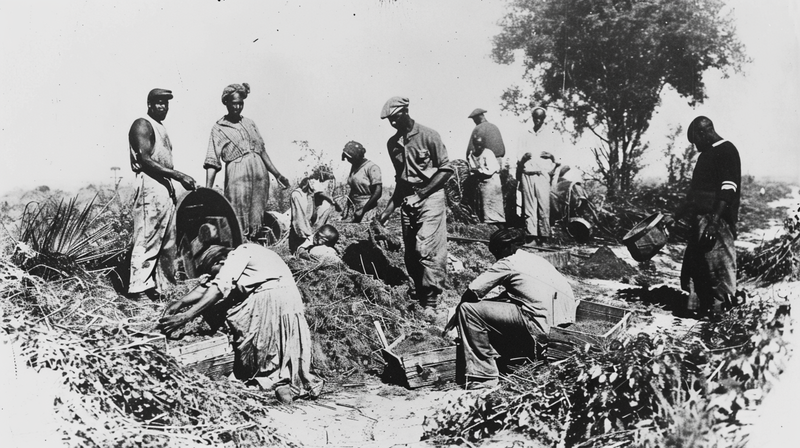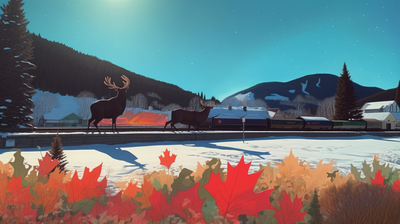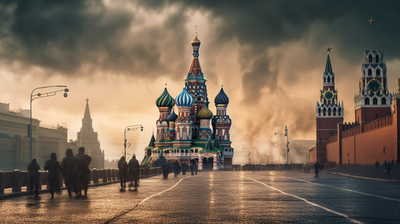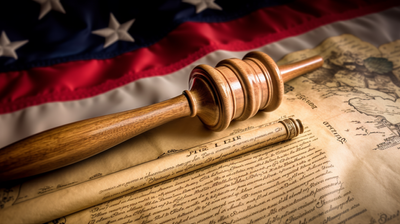Introduction
The Slave Narrative is one of the most under-appreciated aspects of American literature. This is no small part of it being a primarily oral tradition until after Reconstruction. However, thanks to a few authors who recorded their experiences, like Solomon Northrup and Odaulah Equiano, and the work of transcriptionists connected to the Federal Writer's Project and Zora Neale Hurston, much of the slave narrative has been recorded. It has begun to be recognized for its important place in American letters. Not only is slavery America's original sin, but the peculiar institution is also an essential thread in American history. However, there are non-American writers whom we are privileged to read who recounted stories of the Middle Passage and their experiences of slavery as it was practiced in the Caribbean holdings of European powers. The slave narrative has made significant contributions to literature, not just as recounting the often ignored experiences of Africans forcibly transported to the New World but also as their descendants' lived experience. In this paper, I will be discussing the slave narrative as literature both in its historical context, its place in the American Literary canon, and some notes on craft and how it might be different from other forms of American letters.
What Makes a Slave Narrative?
The slave narrative is mainly known for cataloging the lives of slaves and former slaves and their experiences, relationships, and their suffering. Some slave narratives will come from formerly enslaved people directly, but often, their oral tradition was recorded by others. This literary contribution was not fully appreciated until after the Civil Rights movement of the 1960s when many of these narratives gained new prominence. Zora Neal Hurston's Barracoon was not published when she wrote it in the 1920s and was not published in her lifetime. It was privately financed by interested parties in New York City who supported the Harlem Renaissance. The book was finally published in 2018 after selections were published in a biography in 2003.

The Slave Narrative As Literature
When we look at the slave narrative as literature, there is much to mine. It is not just the raw experience of chattel slavery, but it was the vehicle for the abolitionist cause on both sides of the Atlantic. According to Jakub Zenisek in his essay, Slave Narratives as Part of the American Literary Canon, the African-American slave narrative comes in two formats: the non-literary recounting of the institution and the written versions of what began as an oral tradition on the abolitionist lecture circuit. James Olney has noted that the antebellum slave narratives are history, literature, autobiography, and polemic. (Winter, 24) If we dig a little deeper, these narratives can also reveal the peculiar institution's darkest and most secret portions. It can also show the human cost of chattel slavery and accomplish these goals through various formats.
There is also an aspect of telling secrets. The secrets about life as a slave and the mysteries of the master (Lewis, 8-9). This is especially true of sexual secrets, as the master sexually abused slaves, both male and female (Lewis, 9). The sexual lust resulting in children has become more well-known with the public acknowledgment of Thomas Jefferson's black descendants and narrative accounts of slave owners using their slaves for their sexual pleasure. Although the trope of black women being used by men has reached popular film (Lee Daniel's The Butler, 12 Years a Slave), the abuse of male slaves has not been highlighted as often.
In 2021, it became popular among certain African-American circles to highlight the story of "buck breaking," where white slave masters would whip and anally rape male slaves who were not behaving or weren't docile enough. This would often be done in front of the other slaves, adding to the humiliation. The story of buck breaking highlights the oral tradition of the slave narrative. There is written evidence of the practice in French, Dutch, British, and Spanish colonies in the Caribbean, but there is no evidence of the practice being used in the United States. This mostly has to do with the cultural taboo of homosexuality at the time. However, if you approach any black person with this information, they will likely nod along with it because it is a story that has been passed down through families for generations. My dear friend, Teresitz Lewis, mentioned that much of the black experience wasn't written down but often was preserved as stories within families. She believes those stories deserve as much credibility as primary historical sources. Although this is not yet the fact within academia, much of the slave narrative began and was preserved in this same manner.

One of the phases of development mentioned in The Slave Narrative: Its Influence upon Black Publishing and Literature is self-fulfillment and development (Chrisman, 102), which was a popular idea in the narratives before about 1830. This idea was simple: slaves were human beings, too, and deserved the same resources and opportunities as anyone else. To put it in capitalistic terms, the human capital of African slaves was not correctly deployed to its total efficiency.
The bulk of the slave narratives were written to educate a primarily abolitionist reader about the horrors of slavery and the inhumane treatment that slaves were forced to endure. Narratives of the Middle Passage (the transit between Africa and the New World over the Atlantic Ocean) are rare but vital because they tell the horror of overseas travel and how Africans were treated like cargo onboard a ship.
The American version of these narratives is often centered on the American South, although slavery and the resulting racism spread as far north as Rhode Island. The history of slavery in Maryland extends well into Reconstruction. The southern region lends a unique dialect and perspective to the slave narrative, making it unique as literature. It is difficult to find literature set in the South that doesn't address slavery and racism one way or the other.
White Writers and Black Writers
Slave narratives are always more powerful when written by a black hand. However, due to the lack of literacy, these were rare until well after Reconstruction. Even then, some narratives like Zora Neal Hurston's Barracoon were a faithful recounting of the story kept in the oral tradition. However, a few, like the work of Frederick Douglas or Solomon Northrup's 12 Years a Slave, enjoy the privilege of being written by a black hand.
12 Years a Slave is handy as Northrup was born free in the North and was then captured and put into slavery in the South. He spends a great deal of time detailing the slave markets and barracoons of the South and in the natural environment, often making anthropological observations of the world around him and recreating the places where he labored in his tale written after being rescued from slavery. Through his story, we see how fungible "free papers" were and how white men could take advantage of a black man simply because of the color of his skin. An institution like slavery could not exist without the consent of society and the people involved in enforcing it. Northrup and Douglass before him offered opportunities to hear the experience of slavery from the eyes of the people who experienced it as opposed to stories recounted by white abolitionist writers who wrote with a particular agenda toward abolition.

Time
The bulk of the slave narratives were written in the 18th and 19th centuries. Slavery, as an institution, began in the early 1500s with the arrival of African slaves by the Portuguese. The Spanish and French followed this, and the British in 1619.
The Interesting Narrative by Olaudah Equiano was created for the English abolitionist movement of the 18th century, and while it has that in common with its later American cousins, its primary job was to humanize the negro in the mind of Europeans and to show that the negro was indeed human as well with the exact wants, desires, and needs as Europeans and to reject the idea that Africans were somehow a different species of people. Equiano achieves this by telling his own story and revealing the life and traditions of his village before its destruction and the beginning of his enslavement. Equiano would not live to see the end of the British slave trade in 1848. The last slave ship would arrive in the United States in 1860 despite a constitutional prohibition against the slave trade beginning in 1808.
Barracoon by Zora Neal Hurston would catalog the journey of Kossula and his journey on the Clotilda, the last slave ship to arrive in the United States. In some ways, Equiano and Hurston's narratives bookend the story of slavery, at least in America.
Chattel Slavery in the Novus Mundo
Historians have noted that chattel slavery in the New World was a much different institution than slavery in antiquity. The chief difference between slavery in Africa and chattel slavery is between slavery as a matter of class and slavery as a matter of ownership of a human being. The Interesting Narrative demonstrates this. Equiano talks about slavery in his village, where they had slaves, but they were treated like anyone else. The only difference was that they did not marry or own property (like their own hut) and were obliged to live wherever they were told. The villagers worked in the fields alongside the slaves of the village. However, chattel slavery in the New World had little to do with class and much more to do with ownership of black bodies and treating those bodies like animals.

The Experience of Slavery
Slavery and the slave narrative were not monolithic. A diverse set of experiences have been recorded in each of the works that I have read, annotated, and discussed. Equiano shows the British side of slavery and what it was like to serve a man in the British Navy and their adventures during his time at sea. He also gives us insight into how he was made to be different for his hair and skin. Northrup shows us the American side of slavery and what it was like to be born free and suddenly dropped into the institution while unable to navigate it or secure his actual freedom. Kossula in Barracoon shows us the story of someone who was brought to Africa, remembers his African roots, and was brought to slavery in the United States in the cover of darkness, illegally (importation of slaves had been banned for 50 years when he arrived). The slave narrative exposes the reader to various experiences of the enslaved.
In the Federal Writers' Project: Slave Narrative Project from Mississippi (1936), we see clearly how different the treatment of slaves was from the last slaves who left the plantation. One of the unique things about this project is that the people tasked with transcribing these stories did not clean up the language. They did their best to reflect on paper the unique patois of the people who grew up at the end of slavery. This has preserved on paper how they spoke as best reflected. Slavery was not monolithic, and neither are the narratives about it. Although popular history has created the narrative that every slave was eager for freedom and to steal away from the horror of the peculiar institution, this was not always the case.
Former slave James Cameron recounts how the slaves on his plantation near Jackson were not interested in freedom or land. "When folks started a-comin' through talking' 'bout a-freein' us and a-givin' us lan' an' stuff, it didn' take aid Marster's slaves. Us didn't want nothin' to come 'long to take us away from him….Us was livin' in plenty an' peace." (Federal Writers' Project, 19 )
This stands in contrast to the experience of Smity Hodges, "When Marse Cassedy was gone, his overseer would be hard on da slaves, but Marse Cassedy would tell him not to be too hard. He never 'lowed his driver to draw de blood when dye whupped. He fed his slaves. Dey all had gardens, and he tub care of us. He had money in every one of us. De oberseers was white men workin' for wages." (Federal Writers' Project, 69 )
In the slave narrative, some experiences are worth paying particular attention to. That of the middle passage, humans being treated as property, and how religion played a prominent role in the institution of slavery.

The Middle Passage
Barracoon and The Interesting Narrative give us a glimpse into the painful journey of the middle passage. African slaves were bought or captured in West Africa and transported like cargo on wooden sailing vessels headed for ports anywhere from Brazil to Virginia. It was on this journey that Africans began to learn of what faced them. They were often piled head to toe in holds on the straw with a bucket for their waste (if they were lucky) and little else. Food was in short supply, and if the situation on board the ship became dire, they would simply be thrown overboard. There are even stories of people escaping and jumping to avoid the conditions on board. Many Africans who boarded the ships did not survive the brutal journey. Both Barracoon and The Interesting Narrative don't belabor the trip to the New World. Sufficed to say that the trip was brutal, many did not survive, and millions of Africans were transported between Africa and colonies in North America over 400 years.
Religion
Religion plays a large part in the slave narrative and the European attitude towards African people. Equiano points this out, coming "from a climate, where nature, though prodigal of her bounties in a degree unknown to yourselves slave- masters, has left the black man alone scant and unfinished, and incapable of enjoying the treasures she has poured out for him" (Equiano, 81).
"As the three slave narrators show, their kidnappers sought to control black minds and souls as well as black bodies because slave and master alike conceded that the former were Creator-endowed qualities the traffickers in human flesh could not readily steal. Indeed, the belief that the soul symbolizes the original Maker's dominion over people and that it permanently bars all would-be usurpers of this universal supremacy emboldened many slaves to resist and eventually defeat their captors." (Ferguson, 301)
One aspect of religion's role in the peculiar institution was how biblical references to slavery were used to justify its existence and cleanse the consciences of the slave masters. In this extreme example, a disabled slave becomes a metaphor for Jesus Christ, "Frederick Douglass witnesses such a dynamic in the relationship between the slave master Thomas Auld and his already horribly crippled and disfigured slave, Henny, who has little value to Auld except to "bear heavy burdens" (69) and enable the perverted slaveowner to replace the Creator with a culture-bound Christian God who is, ultimately, Auld himself. When he cannot give her away, Auld makes Henny earn her keep by becoming a human sacrifice befitting the most primitive societies. He would tie her up "and whip her with a heavy cowskin upon her naked shoulders, causing the warm red blood to drip; and, in justification of the bloody deed, he would quote this passage of Scripture-'He that knoweth his master's will, and doeth not, shall be beaten with many stripes"' (Douglass, 68). Significantly, the beating continues until blood flows freely and the Christlike Henny shows other signs of suffering since only then does Auld have physical evidence that she has assumed the burden of his sins." (Ferguson, 301)

Many masters did not allow their slaves to attend church or have any religion of their own. However, this was not always the case. In Christian Violence and the Slave Narrative, Ferguson goes on to write that many masters, while not wanting their slaves to get religion, couldn't stop them from seeking out the small churches and black preachers that slaves set up to worship the Christian god. As Africans were imported to the new world, their traditions (most ancestor worship and animism) were stripped away. Christianity was the dominant religion, and that was what most slaves adopted as their own. For slaves born in North America, this was the only religion they ever knew. This is evident in the Christian devoutness of Solomon Northrup in 12 Years a Slave. The idea of salvation, a better life after death, and forgiveness of sins became central to American slave narratives. This was often recorded in music, and those songs became the "negro spirituals" that are still sung to this day. Christianity still plays a significant role in the black community.
Humans as property
The exploration of the slave narrative is fundamentally about cataloging the experience of humans and property and chattel slavery. The idea of slaves dominated slavery in the new world not as a matter of class but as a matter of property. Slaves were treated like animals. Plantation owners bought, sold, and bred slaves like any other animal on the plantation. In records from the period, the number of slaves was counted along with the other property. Slaves could be inherited and passed on to children. Parents could give them to their children, and in some states, they were taxed. In the U.S. Constitution, slaves were counted as 3/5 of a person for representation purposes until Reconstruction.
It is this experience, as property, that is where the slave narrative shines. Rarely have a group of human beings been treated like nothing more than animals in all of human history. Only the Australian Flora and Fauna Act (where aboriginal people were considered animals) compares to the dehumanization of chattel slavery in the New World. This is most poignant in Barracoon and 12 Years a Slave, where both Kossula and Solomon Northrup recount the experiences of being dehumanized and treated like an animal. They were stripped of all clothing for auction and had their bodies poked, prodded, and inspected like sheep or cows. Northrup highlights his experiences in the slave barracoons of New Orleans and spends much of his tale recounting his knowledge and that of Eliza. At one point, Northrup is forced to change his name to please his new buyer. In just a few months, he was bought and sold several times. Eliza had her child ripped away. She could not handle going from living in her master's house as nearly his wife to being sold around the South and losing her beloved daughter.

These slave narratives and these stories are as much a part of the story of the United States as George Washington and the cherry tree. But they have often not been entered into the American literary canon with the same respect as Walden, Moby Dick, or the works of Hemingway, Welty, or other 19th-century writers.
Prominent Slave Narratives
Although I only cite four slave narratives in this paper, the work is far more expansive than discussed here. The result of Frederick Douglass, for example, was crucial in the abolitionist movement in the United States in the 1850s. One of the aspects of the slave narrative is the oral tradition, and often, these stories have been passed down within families for generations before being written down. For the selected works for this paper, I will compare what they have in common and how they differ.
What do they have in common?
Slave narratives tell various stories from different perspectives, but there are some principles they share in common.
Humiliation is a central theme of the slave narrative. There are also themes around the dynamics between white people and black people based solely on skin color. This reinforces the idea that the African person was not civilized and needed the paternal virtue of the white man to civilize him and bring him to be right with the world as defined by white Christians. All four narratives demonstrate the various ways in which people of African descent or from Africa were forced, using violence, to rend their humanity and become less than human.
Another thing slave narratives have in common is the desire for freedom and usually an abolitionist agenda. 12 Years a Slave and The Interesting Narrative were both written for an abolitionist audience and to educate white readers about slavery and the condition of slaves. However, this was not always the case. Barracoon was written long after slavery had ended, as was the Federal Writer's Project on Slave Narratives in Mississippi. The latter projects were meant to preserve the history of slavery so that it would not be forgotten. They also are essential works to help remind people that slavery happened to actual human beings with hopes, thoughts, dreams, spouses, and children.

One of the most exciting parts of slave narratives, particularly those written by a black author, is the otherness of white people. Because of the Master/Slave dynamic, white people are viewed through a lens that we do not often see whiteness portrayed in literature or modern media. In Telling Narratives, Leslie Lewis moves through the debate of the different relationships between slaves and the people who owned them as property. This included Master/Female Slave, Father/Son, and Slave Mothers. Because white people are the instrument of oppression towards black people, they take on a different view. There is no rehabilitation of their image. There is no effort to cleanse them of their part in slavery, which makes for potent storytelling.
Northrup consistently writes about the men who tricked him into becoming drunk or ill and being sold into slavery in Washington, D.C. In his introduction, he remarks that he forgives them and refers to them as evil men. Equiano and Kossula both talk about white people in a novel way because neither of them had seen a white person before being sold into chattel slavery.
In the slave narratives from the Federal Writer's Project, the subjects interviewed speak of white people as another group. They express a distinct separateness toward the people who owned them and to the white people they interacted with after the end of slavery. This is symbolic of the differences still felt to this day but in different terms. The people who left the plantation were always the negroes, and the white people were the masters. White people run the world, and the negroes just live in it. This is a crucial aspect of the slave narrative. There is powerlessness and learned helplessness within that dichotomy.
How do they differ?
Slave narratives can often differ based on the education of the people writing them (or being interviewed) and can vary based on their servitude. Equiano is the personal slave of a British naval officer. His journey begins in Africa and then moves to Bermuda and then to England. After he purchases his freedom, he becomes a prominent businessman and abolitionist. Northrup is a farmer and part-time musician born free in upstate New York and is sold into slavery by two men who had hired him to play music for their show. They stuff his pocket with money and free papers but still betrayed him for greed. These narratives are well-written and include poignant descriptions of their experiences because both of the men were educated. Equiano had a much more domestic sort of labor than Northrup, who worked in the fields and construction. This is in contrast to Barracoon and the Federal Writer's Project transcriptions.

The focus of Barracoon is less on slavery itself and more on the middle passage and the experiences of the last slave ship ever to bring slaves to the United States. Hurston raised money from interested parties in New York City to find Kossula and write down his experience before taking it with him to the grave. Hurston focuses on his life and the events of his life. His time as a slave occupies only a third of the book. Hurston is far more interested in his life in Africa and his life after the Emancipation Proclamation. Hurston writes his story phonetically as he spoke without regard to editing.
The Slave Narratives of Mississippi focuses more closely on the experiences of slavery, but the transcriptionists make an effort to record the narratives as people spoke. They talk about how they owned them, how they were treated, and what daily life was like as a slave. The experiences are as unique as the people. Northrup focuses much more on his suffering and his desire for freedom. He uses precise descriptions of life in east Texas and his journey in New Orleans. The Federal Writer's Project subjects tend to focus on much more mundane matters. Equiano's narrative differs entirely as it takes place 100 years before the others in the 1850s. The Interesting Narrative, Barracoon, and 12 Years a Slave are much better at actual storytelling than the plain interviews of the Federal Writer's Project. However, all four serve a powerful purpose in creating the daily life and times of enslaved persons.
Whether slave narratives are the same or different doesn't matter as much their ability to reflect the diversity of experiences that any person had as property held in the new world. All four works tell an important story; the story of people who often spent their lives at the mercy of others.

The Slave Narrative as Apart of American Literature
The slave narrative does the vital work of telling the story of what happened to the Africans brought to the New World by Europeans. These people were stripped of their culture, language, names, traditions, and religion. They were removed, and they were forced to become something else. The Interesting Narrative does the best job of explaining this process, although it is not American. Separated from their tribal culture, masters in the new world went about their work of "civilizing" a people thought to be completely foreign and not exactly human.
This is where Barracoon is helpful. Kossula can describe the process of being separated from everything he ever knew and transported to an entirely new world. He had never seen a sailing ship before, nor had he even seen the ocean. He was never able to go through the manhood ceremony in his village. This is the story Hurston wanted to record. To give people an idea of what the ancestors of African-Americans had gone through and how it applied to people of her time in the early 20th century.
The slave narrative is a unique opportunity to study both the craft and literary contributions to American letters.

Craft in the Slave Narrative
From a craft perspective, the slave narrative usually takes on two forms: telling the story by the person's hand in standard English or a faithful transcription or retelling.
In Hurston's Barracoon we see her ability to transcribe the experiences of Kossula. The real skill of Barracoon is Hurston's ability to reflect the story of Kossula without adding much of her commentary. For example, this passage at the end of Chapter 5 demonstrates the entirety of the work: (Kossula is speaking)
"Our grief so heavy lak we cain stand it. I think maybe I die in my sleep when I dream about my mama. Oh Lor'!" Kossula sat silent for a moment. I saw the old sorrow seep away from his eyes and the present take its place. He looked about him for a moment and then said bluntly, "I tired talking now. You go home and come back. If I talkeed wid you all de time, I cain makee no garden. You want know too much. You astee so many questions. Dat do, dat do, go on home." I was far from being offended. I merely said, "Well, when can I come again?" "I send my grandson and letee you know, maybe tomorrow, maybe next week." (Hurston, 56)
This creates a consistent dichotomy of the story and notes on how it was transcribed. It also makes a purity of the story. The reader does not have to dig through Hurston's own thoughts and feelings to experience the slave trade through the eyes of Kossula. Based on the text, it is unclear how Hurston feels.
Meanwhile, in a narrative like 12 Years a Slave, Northrup takes great pains in his descriptions and uses the proper English he had to conceal during his enslavement. In Washington, he takes time to describe the slave pen of Burch in Washington. After his beating for claiming he was free, he says of the conditions there, "By this time, I had become stiff and sore; my body was covered with blisters, and it was with great pain and difficulty that I could move. From the window, I could observe nothing but the roof rest on the adjacent wall. At night, I laid down upon the damp, hard floor without any pillow or covering whatever." (Northrup, 18) He also takes time to describe how his wrist and ankle shackled him.

Onboard the ship Orleans; he describes the hold. Even his first attempt at freedom in the most incredible detail, "Should the attack be so sudden and successful as to prevent assistance, the hatch was to remain barred down; otherwise, the salves were to be called up and in the crowd and hurry, and confusion of the time, we resolved to regain our liberty or lose our lives. I was then to assume the unaccustomed place of a pilot and to steer northward; we trusted that some lucky wind might bear us to the soil of freedom." (Northrup, 22) He also describes hiding under a small boat to effectuate this attempt at mutiny and how he tested his ability to hide under it. Overall, this gives a literary effect of being right there. The reader can visualize all sorts of detail.
The Slave Narrative's Contributions to the American Story
12 Years a Slave, Barracoon, and The Federal Writer's Project, all in their unique way, give us crucial information about America's peculiar institution. Although The Interesting Narrative is British, Equiano's work has useful data that can help readers and researchers fill in the gaps in the story of the transatlantic slave trade. However, these stories have not enjoyed the attention that they deserve.
Barracoon was not published in Hurston's lifetime, despite her best efforts. She had terrific connections in publishing in New York City and backing from wealthy donors. The book remained unpublished for decades because no publisher thought anyone would be interested in the content. 12 Years a Slave began as loose papers circulated in abolitionist circles but was published in 1853 to bolster the abolitionist cause. The historical accuracy was in question at the time but was later confirmed by contemporary and modern experts. The Federal Writer's Project was unique in its efforts to preserve the story of those people who had been set free by the Emancipation. Without government support, those stories would have been lost.

The Slave Narrative Today
The slave narrative is an important part of the American story. Since 1619, African slaves have been imported to this country. Over the course of the four narratives, a complete picture of America's original sin begins to form. This is an area where 12 Years a Slave shines. Only in recent memory have the narratives about slavery began their entrance into the literary canon of this country. Their exclusion is three-fold. The first part is simple racism toward people of a different skin tone. The second is an avoidance of national guilt. The third is that the literary establishment has not acknowledged the black story as important. Barraccon was only published in 2018. The book found no home when it was written in 1927. Although The Interesting Narrative and 12 Years a Slave were written for an abolitionist audience to promote abolition of slavery, the Federal Writer's Project and Barracoon were not written in this tradition. Other more modern authors have also struggled to find acceptance for telling black stories and talking about the slave narrative. The slave narrative is a vital part of the American story. Without the slave narrative, the story of the United States is simply incomplete. Work is still being done to have these conversations about the slave narrative. As schools pivot toward doing a better job of teaching children about slavery and racism, aspects of society are pushing back against this story and these narratives. There is active resistance to adding the slave narrative to the American account. The slave narrative is counter to American mythology and represents a significant departure from the American story. On the one hand, there is a narrative around "all men being created equal" and "freedom and liberty for all." The slave narrative shows that the ink on the founding documents wasn't even dry, and these statements were not true at the time. To this day, black Americans do not enjoy the same amount of freedom and liberty as white Americans. The etymology of this double standard begins in the slave narrative.

An American Tale
Slavery is part of the American story, and it is often under-recognized and underutilized. It has been kept out of American mythology. People often think about a romanticized version of the antebellum period as promoted in films and elsewhere. However, there is an important part of the story missing. The slave narratives tell us the other half of the story. The story of the people who worked in the houses and the fields that supported the economy of antebellum America. It is a crucial part of the American story, and the American story is not complete without the slave narrative. Slavery and racism are integral parts of the level of life on the North American continent.
These stories give us a picture of what the life of slaves has been in all its shades and nuances. 12 Years a Slave gives us an on-the-ground report of both sides of life for black Americans in the 19th century. Barracoon and The Interesting Narrative provide us with insight into the Middle Passage and the slave trade as it was practiced. The Federal Writer's Project gives us an important record of how former slaves felt about the institution and their lives after its abolition. These experiences are real, American experiences. The slave narrative as literature lends an important voice to how people have lived and died in the United States. It is an important history of the system of chattel slavery. It is also the way in which we get to understand the lived experiences of the real humans who lived in these conditions. The slave narrative is inextricably tied to the American story, and the four selections show how the slave narrative contributes to that story. The slave narrative is as important as any other literary effort in this country. The slave narrative is complicated and diverse. The only way to understand it is to accept it as an unfortunate but vital part of the American story.

Works Cited
Chrisman, Robert. “The slave narrative: its influence upon black publishing and literature.” The Free Library 22 June 2001. 18 September 2021 <https://www.thefreelibrary.com/The slave narrative: its influence upon black publishing and...-a081826811>.
Equiano, Olaudah. The Interesting Narrative. 1st ed., vol. 1, Penguin Classics, 1995.
Federal Writers’ Project: Slave Narrative Project. 1st ed., vol. 9, Applewood Books, 2001.
Ferguson, SallyAnn H. “Christian Violence and the Slave Narrative.” American Literature, vol. 68, no. 2, Duke University Press, 1996, pp. 297–320, https://doi.org/10.2307/2928299.
Hurston, Zora, Neale. Barracoon. 1st ed., vol. 1, Harper Collins, 2018.
Lewis, Leslie W. Telling Narratives: Secrets in African American Literature. University of Illinois Press, 2007.
Northrup, Solomon. 12 Years A Slave. Black and White Productions, 2015.
Winter, Dave. “The Slave Narrative as a Vehicle to Link History and Literature Instruction.” OAH Magazine of History, vol. 13, no. 2, Oxford University Press, Organization of American Historians, 1999, pp. 24–28, http://www.jstor.org/stable/25163269.






